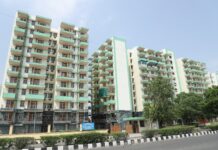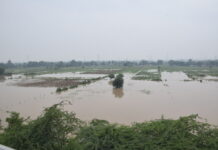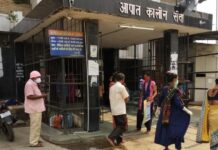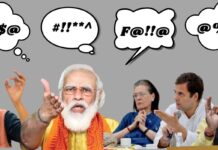[vc_row][vc_column][vc_column_text]
Mahipal Singh is finding all doors of treatment closing on him. With no resources to access treatment for his lung related ailment he is heading to slow but painful demise. The reason for his predicament is lack of government health facilities in the entire district which is barely 100 kilometer from the National Capital. The 60-year-old from a nondescript village is not alone.
There are many like him in Bulandshahr district of Uttar Pradesh who can’t afford quality healthcare due to lack of financial resources.
Mumbling words amid heavy breathing, Mahipal could be able to convey to this writer how the inordinate delay in the treatment is taking a heavy toll on his health. Though terminally ill for at least six months, he is unable even visit a nearby private practitioner regularly as he can’t afford his exorbitant fee. Absence of treatment, he said, was hampering treatment even as his condition had been steadily deteriorating with each passing day.
Like Mahipal, many poor patients in need of critical medical care under specialists have no option but to go without treatment. With little resources at hand, they can have access to community health centers (CHC) or public health center (PHC), which are of no avail as they don’t have no wherewithal to these ill-fated lot.
Mahipal can’t even avail free treatment of up to Rs 5 lakh under the much touted Ayushman Bharat, a Central government’s healthcare scheme. The eligibility criterion under the scheme is such that even the small house and a few beegha land makes him ineligible for the benefits.
While rural India has ever been craving for affordable healthcare services, over the years successive governments at the Centre and in the states chose ignore their healthcare demand. The administration does not want to look beyond CHCs and PHCs to meet the rural healthcare needs. Since these healthcare facilities are not equipped to attend to any critical medical emergency, the only course left for such patients is to wait for death.
This situation is though quite pathetic, civil society rather than addressing the issue chooses to look the other Way. After 70-odd years of Independence, if people suffering from treatable ailments are left to die without medical intervention, it reflects poorly on our system.
Why does our administration not care to ameliorate the grievances of these hapless villagers?
The answer is not far to seek. Healthcare is not a priority for the government. If this is not the case, the budgetary allocation would not have been the measly 1.3 per cent of the GDP. Healthcare spending has always been minuscule in India. While a major part of this miniscule fund goes into building urban healthcare infrastructure, rural healthcare, which is only of secondary importance in our administration’s scheme of things, has to make do with whatever is left out from the health budget.
Hence, while rural India where 70 percent of the country’s population lives, depends on government-run CHC, PHCs and district hospitals which are ill equipped to cater to the healthcare needs of the rural hinterland. These facilities are neglected lot. Due lack of resources, they remain short on manpower, medicine and equipment.
Left with no option, patients from rural hinterland flock to tertiary care units in urban centres as a last resort. But these healthcare centres, which are already overburdened with a stream of local patients to attend to, have no time for these “outsiders” treated as “intruders”. In this situation, while a few lucky ones with recommendations of influential political figures succeed in drawing medical attention, a large number of patients return home hopeless after spending anxious days and nights outside the hospitals.
In this context, I am reminded of an incident of January, 2021. A 32-year-old man with life threatening complications was referred to Delhi from Aligarh, Uttar Pradesh. He was shifted to general ward after keeping him under observation in the ICU at Safdarjung Hospital. As there was no ventilator available at that time his attendants were told to help the patient breath with a manual ventilator till a ventilator is made available to him. But unfortunately the patient could not survive the long wait. Such cases, though common, mostly go unreported.
The way out
There are many ways with which we can address the disparity between the urban and rural healthcare and make quality medical care accessible and affordable to all. But none can work unless the government enhances healthcare spending.
For any positive step towards healthcare for all, the government should first give priority to health infrastructure. It should generously distribute funds among the states to upgrade their respective rural healthcare infrastructure.
PHCs, CHCs and district hospitals should be strengthened with adequate healthcare workers including doctors, nurses, paramedical and sanitation staff.
The need of the hour is a strong political will to give healthcare its due. While the government should resolve to streamline the healthcare system once for all, all political parties should come together on this sensitive issue and extend a helping hand to the government for the noble cause.
The strength of medical professional can be strengthened to address the skewed doctor-patient ratio. Seats for MBBS, post graduate and super specialty courses should be increased in the medical colleges across the country.
This can be achieved by having a medical college affiliated to each district hospital. A large chunk of the medical graduates from these institutions can be assigned with rural duty. This will help prevent exodus of patients from rural areas to urban centres for treatment. Beds, diagnostics, X-Ray machines, MRIs and ventilators should be made available to every PHCs and CHCs.
[/vc_column_text][/vc_column][/vc_row]
Disclaimer: We do undertake rigorous checks on content provided by contributors before publishing the same. If you come across some factual errors, kindly bring this into our notice and we shall review your objection and claim as per our policy and display correction credits and corrections on the article itself.
The opinion expressed in the article is of the writer. Writer is a freelance journalist/journalist based in Delhi





























